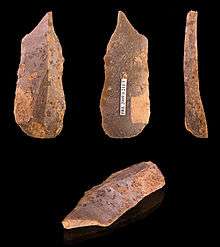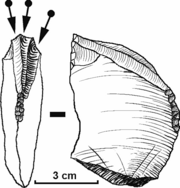Burin (lithic flake)
In the field of lithic reduction, a burin /ˈbjuːrɪn/ (from the French burin, meaning "cold chisel" or modern engraving burin) is a type of handheld lithic flake with a chisel-like edge which prehistoric humans used for engraving or for carving wood or bone.

Burins exhibit a feature called a "burin spall", in which toolmakers strike a small flake obliquely from the edge of the burin flake in order to form the graving edge.[1]
Documented use

Burin usage is diagnostic of Upper Palaeolithic cultures in Europe, but archaeologists have also identified it in North American cultural assemblages, and in his book Early Man in China, Jia Lanpo of Beijing University lists dihedral burins and burins for truncation among artifacts uncovered along the banks of the Liyigon river near Xujiayao.
Burins are diagnostic tools associated with compound microblade projectile technology, found with microblade cores and/or microblades. Their purpose is interpreted as both a rapid retouch and hafting preparation strategy for blade-based edge tools and bifaces and as a class of dedicated flake or blade-based tools used to insert microblades and other microliths into organic armatures.

An example of a type of burin diagnostic of the archaeological stratum where they are found is the "Noailles" burin, named for its original find-site, the Grotte de Noailles, in the commune of Brive-la-Gaillarde, Corrèze, in southwestern France.[2] It consists of a small multiple burin characteristic of the Upper Paleolithic cultural stage called the Gravettian, ca. 28–23,000 BC; these flake tools have been restruck and refined to give several chisellike edges and a blunt, grippable rear edge.
One type of burin is called the "ordinary burin", which occurs when a burin facet is backed against another burin facet.[3]
References
- "burin spall". Archaeology Wordsmith
- Kipfer, Barbara Ann. "Encyclopedic Dictionary of Archaeology". Springer Science & Business Media, 29 Jun 2013
- Burkitt, M. C. (1928). South Africa's Past in Stone and Paint. Cambridge University Press. p. 82. ISBN 9781107641334. Retrieved 2017-08-21.
External links
